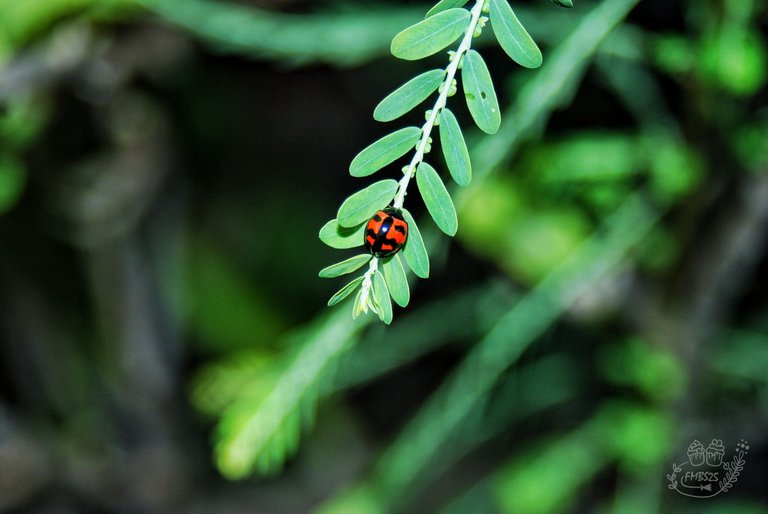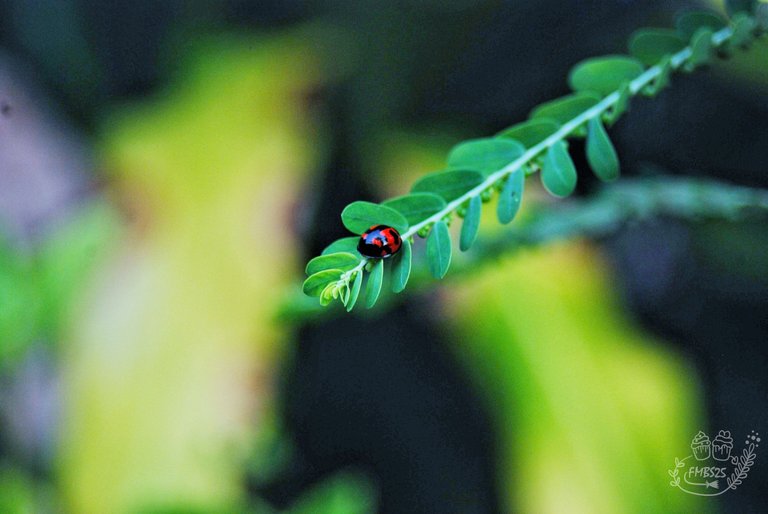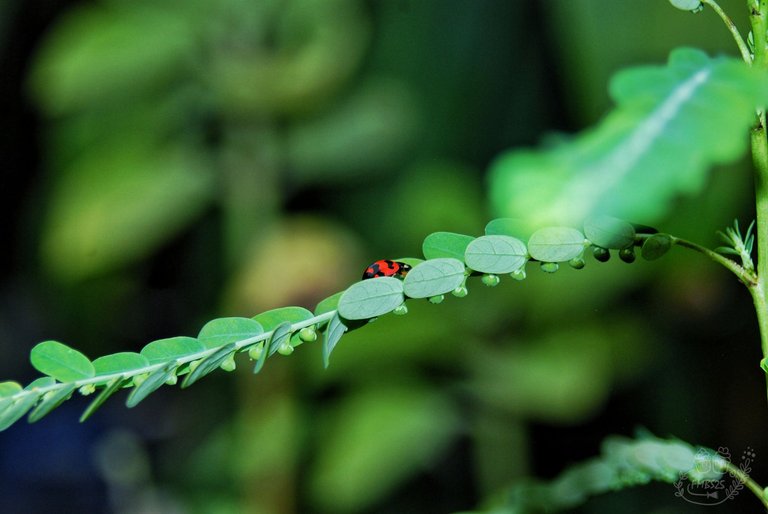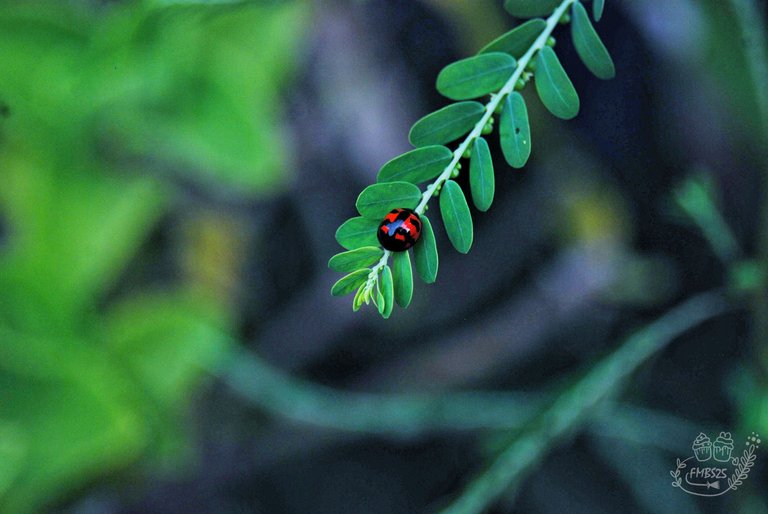In many traditions it is good luck to find a ladybug or Catarina, the truth is that I think so, it is very rare to find these little beauties of animal nature and less common to find them in the garden, so I feel lucky, I think this is the third time I find one of these in my garden, so today I will share again some pictures I took to this little friend and also tell you some of the curious facts that I found on the internet about this little ones.

Ladybugs or also called ladybugs are carnivores and can even engage in cannibalism, yes, cannibalism, because when they are in their larval stage they are able to devour whatever they find on their way, even if this represents their own larval sisters, the female ladybugs that are also capable of laying about 400 eggs, they are able to eat them if they find them again, because these lay their eggs and leave them there and then go to make their normal life (how easy motherhood for these insects), if by chance they return to the site and find them still there, this will be their food of the moment.

They are capable of eating at least about 1000 aphids in a season, that is why they are used by some farmers as an insecticide, so to speak, as they are agents of bio regulation of some pests, including aphids, mites, and some existing parasites on plants, which is why I love to see them in my garden, as I know that if they find something out of control they will help me control that. Their red color makes them look like their main predator, birds, which have an unpleasant taste, although for many in nature the colors red and black mean poison.

These little ones can live between 1 and 3 years, and unlike what many think, the number of spots or dots they have on the cover of their wings do not denote age, what is happening as they age is that their color is losing intensity. They can even lay eggs more than once a year, so it is believed that they can have more than a million of these during their lifetime.

Although they are flying insects, they are very heavy for their wings, so they can not fly long distances, they are very similar to beetles, because, like these, they keep their wings under this kind of shell that gives us their beautiful dress. Instead of biting from top to bottom, they bite sideways, we could say that they do it like pliers or tweezers, it would be interesting to see this up close.

This small one that I found this afternoon in my garden is a Six-spotted Zig Zag Ladybug - Sheilomenes Sexmaculata, by its characteristics I think I was in front of a female of the species, since these show just a white spot on the front of its head, and the male shows a spot in the same way, but that is joining towards the top. It is common to see this species in South American countries.


Images of my own, taken with my Nikon D80 camera and Edited with Snapseed and PicsArt.
Thank you for taking the time to read this post, if you have any questions, criticisms, or suggestions, I would appreciate it if you would put them in the comment box, and remember, You too can make magic in the kitchen and wherever you go!


Created by @derangedvisions

Ladybugs or also called ladybugs are carnivores and can even engage in cannibalism, yes, cannibalism, because when they are in their larval stage they are able to devour whatever they find on their way, even if this represents their own larval sisters, the female ladybugs that are also capable of laying about 400 eggs, they are able to eat them if they find them again, because these lay their eggs and leave them there and then go to make their normal life (how easy motherhood for these insects), if by chance they return to the site and find them still there, this will be their food of the moment.

They are capable of eating at least about 1000 aphids in a season, that is why they are used by some farmers as an insecticide, so to speak, as they are agents of bio regulation of some pests, including aphids, mites, and some existing parasites on plants, which is why I love to see them in my garden, as I know that if they find something out of control they will help me control that. Their red color makes them look like their main predator, birds, which have an unpleasant taste, although for many in nature the colors red and black mean poison.

These little ones can live between 1 and 3 years, and unlike what many think, the number of spots or dots they have on the cover of their wings do not denote age, what is happening as they age is that their color is losing intensity. They can even lay eggs more than once a year, so it is believed that they can have more than a million of these during their lifetime.

Although they are flying insects, they are very heavy for their wings, so they can not fly long distances, they are very similar to beetles, because, like these, they keep their wings under this kind of shell that gives us their beautiful dress. Instead of biting from top to bottom, they bite sideways, we could say that they do it like pliers or tweezers, it would be interesting to see this up close.

This small one that I found this afternoon in my garden is a Six-spotted Zig Zag Ladybug - Sheilomenes Sexmaculata, by its characteristics I think I was in front of a female of the species, since these show just a white spot on the front of its head, and the male shows a spot in the same way, but that is joining towards the top. It is common to see this species in South American countries.


Thank you for taking the time to read this post, if you have any questions, criticisms, or suggestions, I would appreciate it if you would put them in the comment box, and remember, You too can make magic in the kitchen and wherever you go!

[ES]

En muchas tradiciones es de buena suerte encontrarse con una mariquita o Catarina, la verdad es que yo pienso que es así, es muy poco común encontrar estas pequeñas bellezas de la naturaleza animal y menos común encontrarlas en el jardín, por lo que me siento afortunada, creo que esta es la tercera vez que me encuentro con una de estas en mi jardín, así que hoy les compartiré nuevamente algunas fotografías que le hice a esta pequeña amiguita y además comentarles algunos de los datos curiosos que me encontré en internet sobre esta pequeñas.

Las mariquitas o también llamadas catarinas son carnívoros e incluso pueden incurrir en el canibalismo, si, canibalismo, pues cuando están en su etapa larvaria son capaces de devorar lo que encuentren en su camino, aun cuando esto represente a sus propias hermanas larvas, las mariquitas hembras que además son capaces de poner cerca de unos 400 huevos, son capaces de comérselas si las vuelven a encontrar, pues estas ponen sus huevecillos y los dejan allí para luego irse a hacer su vida normal (que fácil la maternidad para estos insectos), si de casualidad vuelven al sitio y las encuentran aún allí, esta será su comida del momento.

Son capaces de comerse al menos unos 1000 pulgones en una temporada, por ello son utilizadas por algunos agricultores como un insecticida, por así decirlo, ya que son agentes de bio regulación de algunas plagas, incluidas los pulgones, ácaros y algunos parásitos existentes en las plantas, motivo por el cual me encanta verlas en mi jardín, pues sé que si encuentran algo fuera de control me ayudaran a controlar eso. Su color rojo le hace ver a su principal depredador, las aves, que tienen un desagradable sabor, aunque para muchos en la naturaleza los colores rojo y negro significan veneno.

Estas pequeñas pueden vivir entre 1 y 3 años, y a diferencia de lo que muchos piensan, la cantidad de manchas o puntos que tienen en la cubierta de sus alas no denotan la edad, lo que va sucediendo a medida que van envejeciendo es que su color va perdiendo intensidad. Pueden poder huevos incluso más de una vez al año, por lo que se cree que pueden tener más de un millón de estos a lo largo de su vida.

Aunque son insectos voladores, son muy pesados para sus alas, por lo que no pueden volar largas distancias, son muy parecidos a los escarabajos, ya que al igual que estos, guardan sus alas bajo esta especie de caparazón que nos regala su tan hermoso vestido. En lugar de morder de arriba hacia abajo, lo hacen de lado, podríamos decir que lo hacen como un alicate o una pinza, sería interesante ver esto de cerca.

Esta pequeña que encontré esta tarde en mi jardín es una Mariquita Zig Zag de Seis Puntos - Sheilomenes Sexmaculata, por sus características creo que estaba frente a una hembra de la especia, ya que estas muestran apenas una mancha blanca en la parte delantera de su cabeza, y el macho muestra una mancha de la misma manera, pero que se va uniendo hacia la parte de arriba. Es común ver esta especie en países de América del sur.


Imágenes de mi propiedad, tomadas con mi cámara Nikon D80 y Editadas con Snapseed y PicsArt.
Gracias por tomarse el tiempo de leer esta publicación, si tiene alguna pregunta, crítica o sugerencia, la agradecería que la pusiera en la caja de comentarios, y recuerda, ¡Tú también puedes hacer magia en la cocina ya dondequiera que vayas!


Created by @robinsonlgil




Come and support @Cervantes as Witness in https://peakd.com/me/witnesses



Las mariquitas o también llamadas catarinas son carnívoros e incluso pueden incurrir en el canibalismo, si, canibalismo, pues cuando están en su etapa larvaria son capaces de devorar lo que encuentren en su camino, aun cuando esto represente a sus propias hermanas larvas, las mariquitas hembras que además son capaces de poner cerca de unos 400 huevos, son capaces de comérselas si las vuelven a encontrar, pues estas ponen sus huevecillos y los dejan allí para luego irse a hacer su vida normal (que fácil la maternidad para estos insectos), si de casualidad vuelven al sitio y las encuentran aún allí, esta será su comida del momento.

Son capaces de comerse al menos unos 1000 pulgones en una temporada, por ello son utilizadas por algunos agricultores como un insecticida, por así decirlo, ya que son agentes de bio regulación de algunas plagas, incluidas los pulgones, ácaros y algunos parásitos existentes en las plantas, motivo por el cual me encanta verlas en mi jardín, pues sé que si encuentran algo fuera de control me ayudaran a controlar eso. Su color rojo le hace ver a su principal depredador, las aves, que tienen un desagradable sabor, aunque para muchos en la naturaleza los colores rojo y negro significan veneno.

Estas pequeñas pueden vivir entre 1 y 3 años, y a diferencia de lo que muchos piensan, la cantidad de manchas o puntos que tienen en la cubierta de sus alas no denotan la edad, lo que va sucediendo a medida que van envejeciendo es que su color va perdiendo intensidad. Pueden poder huevos incluso más de una vez al año, por lo que se cree que pueden tener más de un millón de estos a lo largo de su vida.

Aunque son insectos voladores, son muy pesados para sus alas, por lo que no pueden volar largas distancias, son muy parecidos a los escarabajos, ya que al igual que estos, guardan sus alas bajo esta especie de caparazón que nos regala su tan hermoso vestido. En lugar de morder de arriba hacia abajo, lo hacen de lado, podríamos decir que lo hacen como un alicate o una pinza, sería interesante ver esto de cerca.

Esta pequeña que encontré esta tarde en mi jardín es una Mariquita Zig Zag de Seis Puntos - Sheilomenes Sexmaculata, por sus características creo que estaba frente a una hembra de la especia, ya que estas muestran apenas una mancha blanca en la parte delantera de su cabeza, y el macho muestra una mancha de la misma manera, pero que se va uniendo hacia la parte de arriba. Es común ver esta especie en países de América del sur.


Gracias por tomarse el tiempo de leer esta publicación, si tiene alguna pregunta, crítica o sugerencia, la agradecería que la pusiera en la caja de comentarios, y recuerda, ¡Tú también puedes hacer magia en la cocina ya dondequiera que vayas!






 @Ecotrain Discord @Ecotrain Discord |  |
|---|---|
| https://steemitimages.com/640x0/https://ipfs.busy.org/ipfs/QmNmqVvqjT9vUukyqi1PWVvceFNA32BUqpMj1kME7PdSib @upmewhale Discord |  |




The rewards earned on this comment will go directly to the person sharing the post on Twitter as long as they are registered with @poshtoken.
Su post ha sido valorado por @ramonycajal